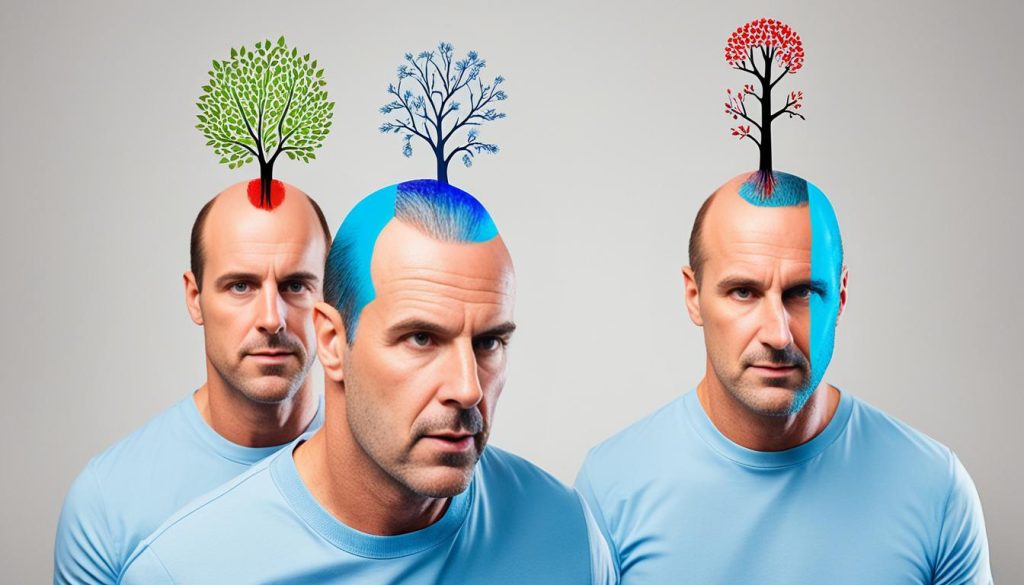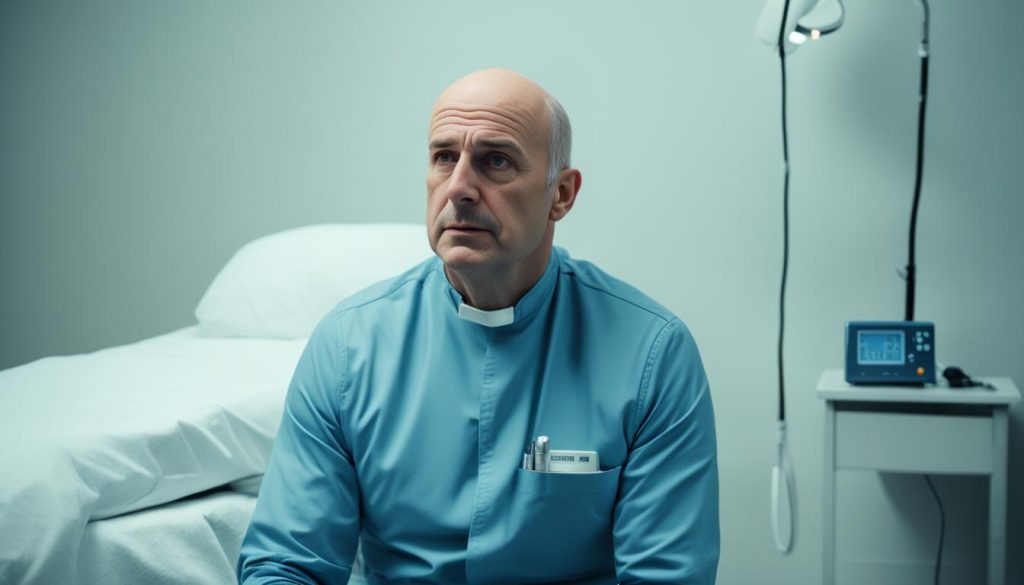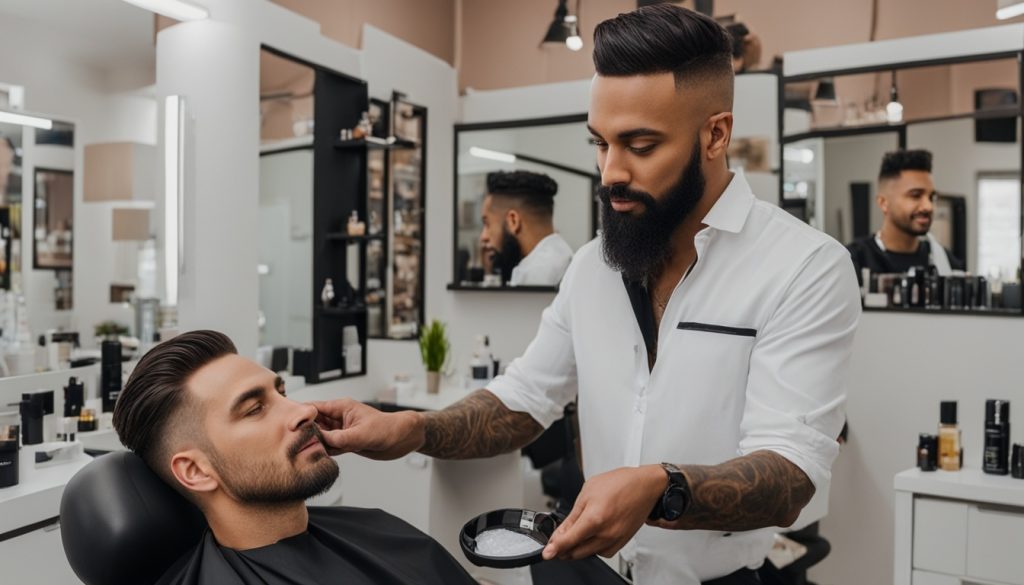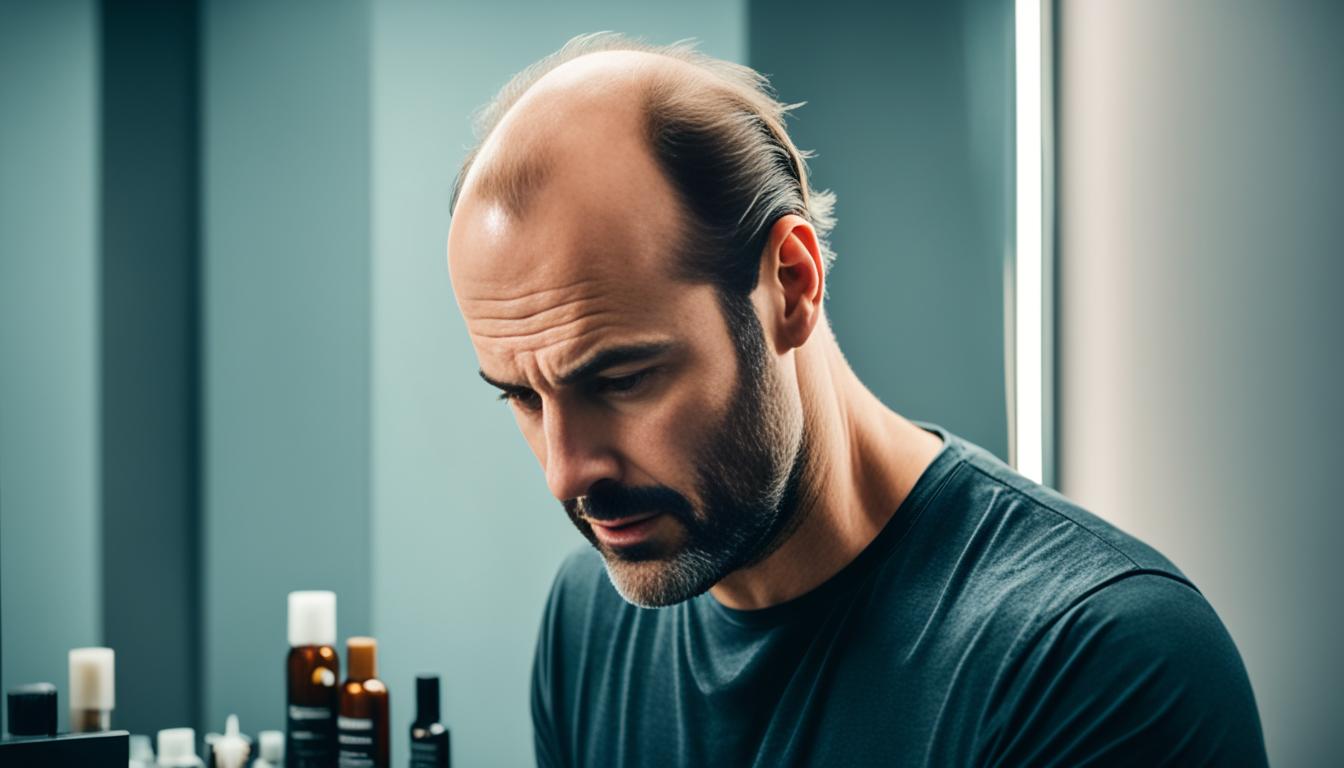Have you ever wondered what causes hair loss in males? It’s not just about male pattern baldness. There are many factors that contribute to hair loss in men. Let’s challenge common beliefs about balding together.
Key Takeaways:
- Male pattern baldness, also known as androgenetic alopecia, is the most common cause of hair loss in men.
- Medical conditions, hormonal changes, medications, hairstyles, and treatments can also lead to hair thinning.
- Genetic predisposition, age, stress, and poor nutrition are risk factors for hair loss.
- Prevention measures, gentle hair care, and quitting smoking can help minimize hair loss.
- Treatment options include topical minoxidil, oral finasteride, hair transplantation, and emerging medical treatments.
Male-Pattern Baldness
Male-pattern baldness is a common type of hair loss in men. It starts with hair thinning at the temples and crown. Over time, the hair becomes finer and sparser, leading to baldness. This condition often comes from your family’s genes.
The cause of male-pattern baldness isn’t completely understood. However, it is linked to androgens, such as dihydrotestosterone (DHT). DHT makes hair follicles shrink, stopping new hair from growing.
Let’s explore how male-pattern baldness progresses and what signs to look for:
Progression of Male-Pattern Baldness
Male-pattern baldness has different stages:
- Stage 1: There’s a slight hairline recession at the temples.
- Stage 2: The recession creates an “M” shape. Thinning on the crown starts.
- Stage 3: The “M” deepens. The crown thins out more, forming a bald spot. The front and top start to merge into a horseshoe shape.
- Stage 4: The “M” is more pronounced and the crown’s bald spot grows. The horseshoe shape is clearer.
- Stage 5: The hairline recedes more, leaving a thin strip of hair. The bald spot on the crown gets larger.
- Stage 6: The top strip of hair thins out and the crown’s bald spot expands more.
- Stage 7: Finally, only a narrow band of hair is left with a mostly or completely bald crown.
The extent of baldness varies among individuals.
Medical Conditions and Hormonal Changes
Hair loss in men can link to various medical conditions and hormonal shifts. These factors can have a big impact on how hair grows. By understanding them, it’s possible to find the right treatment options.
Alopecia Areata
Alopecia areata is a condition where the immune system attacks hair follicles. This attack leads to patchy hair loss. The exact reasons are still unclear, but genes and the environment might play a role.
Thyroid Problems
The thyroid gland is key to regulating our hormones. An overactive or underactive thyroid can throw off this balance. This imbalance can make hair fall out fast or grow slowly and become brittle.
Pregnancy-Related Hair Loss
Changes in hormones during pregnancy, childbirth, and menopause can cause men’s hair to fall out temporarily. Levels of estrogen and progesterone go up and down during these times. This can mess with the hair’s growth cycle. After childbirth, some men might experience a lot of hair shedding.
Other Medical Conditions
Other issues, like scalp infections or trichotillomania, can also cause hair to fall out. Ringworm can damage hair follicles. Trichotillomania is when someone can’t stop pulling their hair. It’s crucial to see a healthcare professional to figure out these conditions.

Medications and Treatments
Some medications and treatments can cause hair loss in men. Knowing the side effects of your medicines is important. Speak with a healthcare expert about them. Drugs for cancer, arthritis, depression, heart issues, gout, and high blood pressure might lead to hair loss.
Chemotherapy, used to treat cancer, is a common cause. It targets fast-growing cells, like those in hair follicles, causing hair to fall out. However, hair usually grows back after chemotherapy ends. Radiation therapy, another treatment for cancer, can also result in hair loss in the treated area.
Below is a table highlighting some medications that may cause hair loss as a side effect:
| Medication | Condition |
|---|---|
| Docetaxel (Taxotere) | Cancer |
| Cyclophosphamide (Cytoxan) | Cancer, autoimmune diseases |
| Lithium | Bipolar disorder |
| Warfarin (Coumadin) | Blood thinning |

Not everyone experiences severe hair loss from these medications. The impact varies among individuals. If you’re worried about losing hair due to medicine, talk to your healthcare provider. They can suggest different treatments or ways to lessen hair loss or stimulate new growth.
Hairstyles and Hair Treatments
Some hairstyles and treatments can lead to hair loss in men. Hairstyles such as tight braids or cornrows cause tension alopecia. This happens when there’s too much pull on the hair follicles. Choosing hairstyles that don’t stress the hair is better for its health and growth.
Hot-oil treatments and harsh chemicals also harm hair. Using hot-oil treatments often can break the hair. Likewise, harsh treatments like perms damage hair follicles, leading to loss. Limiting these and choosing softer options is key for healthy hair.
The Impact of Scarring
Some treatments can cause scarring and permanent hair loss. Harsh chemicals, if used wrong, harm the scalp and follicles leading to scarring. Following instructions and getting professional advice is vital to avoid these risks.
To prevent hair loss, focus on hair and scalp health. Gentle care and a good routine are essential. Moisturizing, using soft shampoos, and avoiding too much heat keep hair strong and healthy.

| Hairstyles Causing Hair Loss | Hot-Oil Treatments and Hair Loss |
|---|---|
| Tight braids | Excessive use of hot-oil treatments |
| Cornrows | Frequent application of heat to the hair |
| Ponytails | Overuse of chemical treatments like perms |
By picking gentle hair treatments and styles, men can keep their hair healthy. If hair loss gets bad, seeing a health expert or a dermatologist is wise. They can give advice and suggest treatments.
Other Causes and Risk Factors
Apart from mentioned causes, there are other factors that can lead to hair loss in men.
Family history: Genetics is a big factor in hair loss, responsible for around 80% of cases. If your family members, like parents or grandparents, lost their hair, you might too.
Age: As men get older, losing hair becomes more common. This is due to changes that happen with age.
Other risk factors: Losing a lot of weight, having certain illnesses like diabetes and lupus, stress, and not eating well can also make hair loss more likely in men.
“Multiple factors, including genetics, age, and more, can make hair loss complex. Knowing these can help people choose how to prevent or treat it.”
Prevention and Maintenance
Some types of hair loss can’t be stopped, but you can lessen the risk or slow it down. There are steps men can take to protect their hair.
Gentle care is key for healthy hair. Using detanglers prevents knots and tangles. Avoid pulling wet hair to stop breakage. Treat your hair gently and skip harsh styling to preserve its strength and avoid damage.
It’s also vital to shield your hair from UV damage. Too much sun can weaken follicles and cause hair loss. Wear a hat or use SPF spray when outside for a long time to protect your hair.
Quitting smoking is essential for preventing hair loss too. Research links smoking to higher hair loss risk. Cigarette smoke harms follicles, making hair weak and brittle. Stop smoking to boost your health and your hair’s vitality.
To keep your hair healthy, follow these tips: care for your hair gently, protect it from the sun, and quit smoking. These actions can help prevent hair loss and keep your hair strong.
Treatment Options
Many men facing hair loss have different treatments to choose from. These treatments aim to boost hair growth, stop hair loss, and enhance hair health. Here are some effective treatments:
Topical Minoxidil
A known hair loss remedy is topical minoxidil. It comes as a solution or foam to apply on the scalp. This aims to awaken hair follicles and lengthen their growth phase. People use minoxidil twice daily and it has helped many by reducing hair loss and making hair thicker.
Oral Finasteride
Oral finasteride is another treatment that targets hair loss in men. It works by blocking a specific hormone, DHT, which causes hair to thin. This can halt hair loss and encourage new growth. But, a doctor must prescribe it and guide its use.
Hair Transplantation
Hair transplantation is a surgical technique that moves hair from full to thinning areas. It works well for male-pattern baldness. The results look natural and are permanent, making it a favored option for a lasting fix to hair loss.
Emerging Medical Treatments
New medical treatments for hair loss are being tested. These include various medications, growth treatments, and laser therapy. Although they show promise, more studies are needed to prove they work and are safe.
Seeking advice from a hair loss specialist is crucial. They can suggest the best treatment for you based on your situation. Their expert advice can guide you to a suitable solution for your hair loss.
Psychosocial Impact
Hair loss can deeply affect a man’s mental health. It’s more than a change in looks. It often leads to stress and negative feelings. Dealing with it means tackling these emotions and finding support.
Emotional Distress and Self-Esteem
Hair loss can make a person feel anxious, sad, and less confident. Accepting this change can be hard. It may cause someone to shy away from others.
“Losing my hair affected my confidence and how I saw myself. It made me feel less attractive and older than I actually am. It took a toll on my self-esteem.”
Coping Strategies
Finding ways to cope with hair loss is key. Getting help from experts can guide you through treatments. They also help deal with the emotional side of hair loss.
- Self-care: Doing things that are good for your body and mind can lower stress and lift your spirits.
- Talking to others: Support groups and online forums offer a place to share and learn from others in the same boat.
- Embracing the change: Seeing hair loss in a new light and staying positive can improve your mental health.
Professional Support and Resources
Doctors and psychologists can offer specialized help. They discuss treatments and cosmetic solutions. Plus, they help with the emotional effects of losing hair.
Getting support doesn’t stop with doctors. There are many groups and websites where men can find help, talk about their experiences, and get advice from others who understand what they’re going through.
“Connecting with others who are going through the same experience has been a tremendous source of support for me. It made me realize that I’m not alone and gave me the strength to cope.”
It’s good to seek help for hair loss. Remember, many men experience it, and there’s a lot of support out there to help you through it.
Professional Help and Support Resources
| Resource | Description |
|---|---|
| American Hair Loss Association | A nonprofit organization providing educational resources, support groups, and access to expert advice for individuals experiencing hair loss. |
| National Alopecia Areata Foundation | An association dedicated to supporting individuals with alopecia areata and promoting research for better treatment options. |
| Online Communities | Platforms such as Reddit’s hair loss communities and online forums provide support, advice, and a space to share experiences with fellow individuals. |
| Hair Loss Support Groups | Local support groups, both in-person and online, create an environment for sharing experiences, building connections, and finding mutual support. |
Conclusion
Male hair loss results from genetics, hormones, health issues, and lifestyle choices. Male pattern baldness is the most frequent type, caused by genes and DHT hormones. Other reasons include illnesses, medicines, hairstyles, and some treatments.
Men can reduce hair loss effects through careful actions. Using gentle hair care and shielding hair from the sun helps keep follicles healthy. Treatments like minoxidil, finasteride, and hair transplants can also fight hair loss and aid growth.
Dealing with hair loss’s emotional side is vital too. Support from doctors, groups, or online can boost emotional health. It’s critical to see a doctor to find the hair loss cause and get the right treatment.




